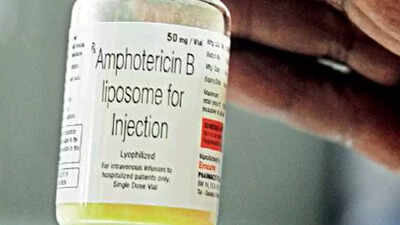Top Searches
- News
- City News
- bengaluru News
- Karnataka sees over 4,000 mucormycosis cases; dip since August
Karnataka sees over 4,000 mucormycosis cases; dip since August
Karnataka sees over 4,000 mucormycosis cases; dip since August

Acute shortage of the antifungal drug Amphotericin B had led to hindrances in treatment
BENGALURU: Karnataka has seen 4,125 cases of mucormycosis till October 22 since the second wave of the pandemic broke out in April this year. There have been 476 deaths due to the post-Covid fungal infection during the period.
The fungal infections, however, have reduced after the ebbing of the Covid wave August onwards. “Across the state, 59 mucormycosis cases and four deaths were reported in October till Friday,” health department officials said.
The state began collating mucormycosis data (including April cases) in early May after a spike in the cases post the second wave. The onset of mucormycosis generally happens two weeks after Covid, but there have been instances of the same being reported even when the person is still infected.
Bengaluru, the epicentre of the second wave of Covid infections, reported the highest number of mucormycosis cases in the state:
After Bengaluru, the highest number of mucormycosis cases were seen in Vijayapura (308), followed by Belagavi (283) and Kalaburagi (217). Bagalkot and Chitradurga reported 212 each. In all, eight districts recorded more than 200 cases each. Kodagu saw the least (3) and and zero deaths.
Dr Suresh NV, district surgeon, Bengaluru, said cases in the state capital have come down. Fourteen cases and one death have been reported in the city in October till Friday, as per the data with Dr Suresh. However, hospitals have been seeing some patients coming for follow-up consultations and corrective procedures.
It may be recalled that during the second wave, several patients who were diabetic and put on steroids for long were affected by the fungal injection during or post-Covid treatment. In multiple cases, vision was lost as the fungus penetrated the eyes. An acute shortage of the antifungal drug Amphotericin B also led to hindrances in treatment.
Strangely, some mucormycosis patients showed no symptoms of Covid and were not on steroids too. They showed presence of Covid antibodies when tested for past exposure to SARS-CoV2.
While there are no clear answers on what led to the rise of mucormycosis infections amid the pandemic, one of the theories is that the Delta variant, steroid usage and high diabetes status were the causative factors.
Dr Deepak Haldipur, ENT surgeon, Trustwell Hospital, suspects that the surge in mucormycosis cases was largely due to the Delta variant. “In multiple cases, we saw increased blood sugar levels, which could be due to the variant. However, the hospital has seen no fresh cases in the past one and half months,” he said.
The fungal infections, however, have reduced after the ebbing of the Covid wave August onwards. “Across the state, 59 mucormycosis cases and four deaths were reported in October till Friday,” health department officials said.
The state began collating mucormycosis data (including April cases) in early May after a spike in the cases post the second wave. The onset of mucormycosis generally happens two weeks after Covid, but there have been instances of the same being reported even when the person is still infected.
Bengaluru, the epicentre of the second wave of Covid infections, reported the highest number of mucormycosis cases in the state:
755. Ninety of the patients died.
After Bengaluru, the highest number of mucormycosis cases were seen in Vijayapura (308), followed by Belagavi (283) and Kalaburagi (217). Bagalkot and Chitradurga reported 212 each. In all, eight districts recorded more than 200 cases each. Kodagu saw the least (3) and and zero deaths.
Dr Suresh NV, district surgeon, Bengaluru, said cases in the state capital have come down. Fourteen cases and one death have been reported in the city in October till Friday, as per the data with Dr Suresh. However, hospitals have been seeing some patients coming for follow-up consultations and corrective procedures.
It may be recalled that during the second wave, several patients who were diabetic and put on steroids for long were affected by the fungal injection during or post-Covid treatment. In multiple cases, vision was lost as the fungus penetrated the eyes. An acute shortage of the antifungal drug Amphotericin B also led to hindrances in treatment.
Strangely, some mucormycosis patients showed no symptoms of Covid and were not on steroids too. They showed presence of Covid antibodies when tested for past exposure to SARS-CoV2.
While there are no clear answers on what led to the rise of mucormycosis infections amid the pandemic, one of the theories is that the Delta variant, steroid usage and high diabetes status were the causative factors.
Dr Deepak Haldipur, ENT surgeon, Trustwell Hospital, suspects that the surge in mucormycosis cases was largely due to the Delta variant. “In multiple cases, we saw increased blood sugar levels, which could be due to the variant. However, the hospital has seen no fresh cases in the past one and half months,” he said.
FacebookTwitterLinkedinEMail
Start a Conversation
end of article

